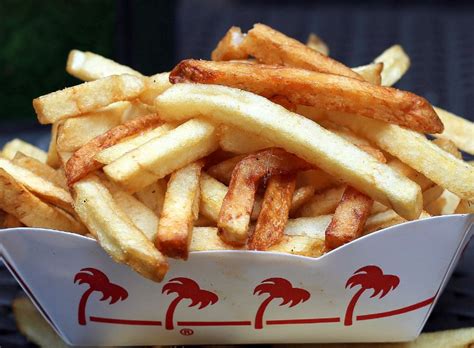
Ordering In-N-Out Burger’s fries “well-done” is reportedly the key to avoiding the chain’s notoriously soggy potatoes, according to a recent Yahoo! Life article. This simple modification ensures a crispier texture, addressing a common complaint among customers.
For In-N-Out Burger fans who have long struggled with the chain’s sometimes underwhelming french fries, there may be a solution beyond simply accepting the status quo. According to a recent report, requesting your fries “well-done” can dramatically improve their texture, resulting in a crispier, more satisfying experience. The suggestion, highlighted in a Yahoo! Life article, addresses a recurring concern among In-N-Out customers who find the standard fries to be often soggy or lacking in crispness.
The issue of In-N-Out’s fries has been a long-standing topic of debate and discussion among food critics, bloggers, and casual diners alike. While the burger chain enjoys a cult-like following, particularly on the West Coast, its fries have often been singled out as a weak point in an otherwise stellar menu. The standard preparation method, which involves freshly cutting the potatoes in-house and then frying them, sometimes results in fries that are soft and limp rather than the golden, crispy delights many customers expect.
The “well-done” hack offers a straightforward workaround to this problem. By specifically requesting that the fries be cooked for a longer period, customers can ensure that more moisture is removed from the potatoes during the frying process. This leads to a significantly crispier exterior and a more structurally sound fry that holds up better to dips and toppings.
“Requesting your fries ‘well-done’ ensures they’re cooked longer, resulting in a crispier texture,” the Yahoo! Life article explains, confirming the simple yet effective solution. For those accustomed to the standard In-N-Out fry experience, this adjustment can be a game-changer, transforming a potentially disappointing side into a truly enjoyable part of the meal.
This advice is particularly valuable considering In-N-Out’s commitment to freshness and its minimal use of preservatives. The chain prides itself on using fresh, whole potatoes that are cut and cooked on-site, a practice that distinguishes it from many other fast-food establishments that rely on pre-cut, frozen fries. While this commitment to freshness is admirable, it also means that the frying process is crucial in determining the final texture of the fries. Unlike frozen fries, which often contain additives that help them maintain their crispness, In-N-Out’s fresh-cut fries are more susceptible to becoming soggy if not cooked properly.
The “well-done” modification essentially compensates for the lack of additives by ensuring that the fries are cooked to a point where they achieve optimal crispness. This is especially important for customers who prefer a more substantial bite and a fry that can stand up to the weight of ketchup, spread, or even being piled high on a burger.
It’s worth noting that the “well-done” request may result in a slightly darker color and a potentially firmer texture overall. However, for many customers, these trade-offs are well worth it in exchange for fries that are consistently crispy and enjoyable.
In addition to the “well-done” hack, some In-N-Out enthusiasts have also suggested other modifications to improve the fry experience. These include ordering the fries “lightly salted” to control the sodium content and prevent them from becoming overly salty, or requesting them “animal style,” which involves topping them with melted cheese, grilled onions, and In-N-Out’s signature spread. While these modifications can further enhance the flavor and texture of the fries, the “well-done” request remains the most effective way to address the underlying issue of sogginess.
The popularity of the “well-done” hack highlights the importance of customization in the fast-food industry. In-N-Out, in particular, has built a loyal following by allowing customers to personalize their orders to a significant degree. From the secret menu to various ingredient modifications, the chain encourages customers to experiment and create their perfect meal. The “well-done” fry request is simply another example of this customization in action, allowing customers to tailor their fries to their specific preferences.
Ultimately, the “well-done” fry hack is a testament to the power of simple solutions and the willingness of customers to share their experiences and tips with others. In a world where fast food is often criticized for its lack of quality and consistency, the ability to customize and improve one’s meal can make a significant difference in overall satisfaction. For In-N-Out Burger fans who have long been searching for a way to enjoy consistently crispy fries, the “well-done” request may be the answer they’ve been waiting for. It’s a simple, effective, and widely available modification that can transform a potentially disappointing side into a truly enjoyable part of the In-N-Out experience.
This also brings forth a wider discussion of food preparation nuances. Different potatoes have different starch contents, which affect how they react to frying. In-N-Out uses fresh potatoes, which can vary slightly in composition depending on the season and the source. This inherent variability further emphasizes the importance of the “well-done” request, as it provides an additional layer of control over the final product. The extra cooking time can help to mitigate the effects of variations in potato starch content, resulting in a more consistent level of crispness.
Moreover, the type of oil used for frying and its temperature play a critical role in achieving the desired texture. In-N-Out uses a specific type of oil and maintains a consistent frying temperature, but even slight fluctuations in temperature can affect the outcome. By requesting the fries “well-done,” customers are essentially asking the cooks to compensate for any potential temperature variations by ensuring that the fries are cooked for a longer period.
It is also worth noting that the perception of “soggy” fries can be subjective. What one person considers to be perfectly acceptable may be deemed unsatisfactory by another. However, the widespread discussion and adoption of the “well-done” hack suggest that a significant number of In-N-Out customers share a similar preference for crispier fries. This underscores the importance of businesses listening to customer feedback and being willing to adapt their practices to meet evolving preferences.
The In-N-Out example can be extrapolated to other food service businesses as well. Customization, transparency in food preparation, and a willingness to accommodate customer requests can lead to increased satisfaction and loyalty. In an era where consumers have access to a wealth of information and options, businesses that prioritize customer experience and strive to meet individual needs are more likely to thrive.
In conclusion, the “well-done” fry hack at In-N-Out Burger is more than just a simple trick; it’s a reflection of the evolving relationship between businesses and consumers. It highlights the importance of customization, the value of customer feedback, and the power of simple solutions in enhancing the overall dining experience. For those seeking consistently crispy fries at In-N-Out, the “well-done” request is a readily available and highly effective option.
The act of ordering fries “well-done” also reflects the broader trend of food hacking and customization that has become increasingly popular in recent years. With the rise of social media and online communities, individuals are more likely to share their culinary discoveries and tips with others, creating a collective knowledge base that empowers consumers to take control of their dining experiences. The “well-done” fry hack is just one example of how this collective knowledge can be used to improve the quality and enjoyment of fast food.
Furthermore, the success of the “well-done” fry hack underscores the importance of clear communication between customers and restaurant staff. By clearly articulating their preferences, customers can help to ensure that their orders are prepared to their exact specifications. This requires both a willingness on the part of the customer to express their needs and a willingness on the part of the restaurant staff to listen and accommodate those needs. In the case of In-N-Out, the chain’s commitment to customer service and its willingness to customize orders have undoubtedly contributed to the popularity of the “well-done” fry hack.
However, it’s also essential to acknowledge that the “well-done” fry hack may not be universally appealing. Some individuals may prefer the softer texture of standard In-N-Out fries, while others may find that “well-done” fries are too crispy or dry. Ultimately, the best way to determine whether the “well-done” fry hack is right for you is to try it for yourself and see how it compares to the standard fry experience.
The story of the “well-done” fry hack also serves as a reminder that even seemingly minor details can have a significant impact on the overall dining experience. The texture of french fries may seem like a trivial matter, but for many customers, it can make the difference between a satisfying meal and a disappointing one. By paying attention to these details and being willing to experiment with different preparation methods, restaurants can enhance the satisfaction of their customers and build a loyal following.
In the context of In-N-Out Burger, the “well-done” fry hack is particularly relevant because the chain is known for its simplicity and its focus on quality ingredients. Unlike many other fast-food restaurants, In-N-Out offers a limited menu and emphasizes fresh, made-to-order food. This commitment to quality means that even small changes in the preparation process can have a noticeable impact on the final product. The “well-done” fry hack is a perfect example of this, as it demonstrates how a simple modification can significantly improve the texture and enjoyment of the chain’s fries.
Moreover, the “well-done” fry hack is consistent with In-N-Out’s overall philosophy of customization and customer service. The chain has long been known for its willingness to accommodate customer requests and its commitment to providing a personalized dining experience. The “well-done” fry hack is simply another example of this commitment, as it allows customers to tailor their fries to their specific preferences.
In addition to the “well-done” fry hack, there are several other ways to customize your In-N-Out order to improve the fry experience. For example, you can order your fries “lightly salted” to reduce the sodium content, or you can request them “animal style,” which involves topping them with melted cheese, grilled onions, and In-N-Out’s signature spread. These modifications can further enhance the flavor and texture of the fries and create a more personalized dining experience.
Ultimately, the “well-done” fry hack is a testament to the power of customer feedback and the importance of customization in the fast-food industry. By listening to their customers and being willing to adapt their practices, restaurants can enhance the satisfaction of their customers and build a loyal following. For In-N-Out Burger fans who have long been searching for a way to enjoy consistently crispy fries, the “well-done” request may be the answer they’ve been waiting for. It’s a simple, effective, and widely available modification that can transform a potentially disappointing side into a truly enjoyable part of the In-N-Out experience.
The article also indirectly highlights the importance of transparency in food preparation. Customers appreciate knowing how their food is prepared and what ingredients are used. In-N-Out’s open kitchen concept, where customers can watch their food being made, contributes to this sense of transparency. Knowing that the fries are made from fresh potatoes cut on-site makes customers more willing to experiment with modifications to achieve their desired texture. This transparency builds trust and encourages customer engagement.
Furthermore, the “well-done” fry hack illustrates the concept of “off-menu” items or customizations. Many restaurants, including In-N-Out, have unofficial menu items or modifications that are not publicly advertised but are well-known among loyal customers. These “secret” menu items often originate from customer requests or employee innovations. The “well-done” fry hack is a prime example of this phenomenon. It demonstrates how customer-driven innovations can become part of the restaurant’s culture and contribute to its unique appeal.
The success of the “well-done” fry hack also highlights the role of online communities and social media in disseminating information about food and dining. The Yahoo! Life article itself is a testament to this, as it shares a tip that has likely been circulating among In-N-Out fans for some time. Online forums, social media groups, and food blogs play a crucial role in sharing culinary tips, reviews, and recommendations, empowering consumers to make informed dining choices.
In addition, the “well-done” fry hack underscores the importance of managing customer expectations. In-N-Out is known for its consistently high quality, but even the best restaurants can sometimes fall short of customer expectations. By offering a simple modification like the “well-done” fry hack, In-N-Out can address a common complaint and ensure that more customers have a positive dining experience. Managing customer expectations is a critical aspect of customer service, and the “well-done” fry hack is a practical example of how this can be achieved.
The “well-done” fry hack also relates to the broader topic of food science and the factors that influence the texture and flavor of fried foods. The Maillard reaction, a chemical reaction between amino acids and reducing sugars that occurs during cooking, is responsible for the browning and flavor development in fried foods. Cooking fries “well-done” allows the Maillard reaction to proceed further, resulting in a darker color, a crispier texture, and a more intense flavor. Understanding the science behind food preparation can help consumers make informed choices about how to cook and order their food.
Moreover, the “well-done” fry hack highlights the interplay between personal preferences and standardized recipes. Restaurants typically use standardized recipes to ensure consistency in their food preparation. However, individual customers often have unique preferences and may want to customize their orders to suit their tastes. The “well-done” fry hack is a simple way for customers to express their preferences and deviate from the standardized recipe. Balancing the need for consistency with the desire for customization is a challenge that all restaurants face.
Finally, the “well-done” fry hack is a reminder that even the simplest things can make a big difference in the overall dining experience. The texture of french fries may seem like a minor detail, but it can have a significant impact on customer satisfaction. By paying attention to these details and being willing to experiment with different preparation methods, restaurants can create a more enjoyable and memorable dining experience for their customers.
Frequently Asked Questions (FAQs):
1. Why are In-N-Out fries often described as soggy?
In-N-Out uses fresh, whole potatoes that are cut and cooked on-site. This commitment to freshness, while admirable, means the fries lack the additives found in pre-cut, frozen fries that help maintain crispness. The standard frying process sometimes results in fries that are soft and limp if not cooked adequately to remove moisture. The Yahoo! Life article indirectly points to this issue, explaining that ordering “well-done” ensures the fries are cooked longer, mitigating the sogginess.
2. How does ordering fries “well-done” solve the sogginess problem?
Requesting “well-done” instructs the cooks to fry the potatoes for a longer duration. This extended cooking time removes more moisture from the potatoes, leading to a crispier exterior and a more structurally sound fry. As the original article suggests, this is the simple solution to get non-soggy fries at In-N-Out.
3. Will ordering fries “well-done” change the taste or appearance of the fries?
Yes, “well-done” fries will likely have a slightly darker color and a potentially firmer texture overall. However, many customers find these trade-offs worthwhile for the significantly improved crispness. The Maillard reaction, responsible for browning and flavor, is more pronounced in well-done fries, contributing to a richer taste.
4. Are there any other ways to customize In-N-Out fries besides ordering them “well-done”?
Yes, customers can also order fries “lightly salted” to control sodium content or “animal style,” which adds melted cheese, grilled onions, and In-N-Out’s signature spread.
5. Is the “well-done” fry hack officially endorsed by In-N-Out Burger?
While In-N-Out Burger doesn’t explicitly advertise the “well-done” option, the chain is known for its willingness to accommodate customer requests. The fact that employees readily fulfill this request suggests it’s a widely accepted practice within the company, even if it is not officially promoted. The yahoo article doesn’t mention endorsement from In-N-Out Burger, but confirms the effectiveness of the hack based on customer experience.
6. What kind of potatoes does In-N-Out use for their fries?
While In-N-Out doesn’t publicly disclose the exact variety of potato they use, it is generally understood that they use Russet potatoes or a similar variety known for its high starch content. This type of potato is well-suited for frying because the starch helps to create a crispy exterior.
7. Does the oil type used for frying affect the crispiness of the fries?
Yes, the type of oil used for frying plays a crucial role in achieving the desired texture. In-N-Out uses a specific type of vegetable oil and maintains a consistent frying temperature, which contributes to the overall quality of the fries. The high smoke point and neutral flavor of the oil are important factors in ensuring that the fries are cooked properly without becoming greasy or developing undesirable flavors.
8. How does the freshness of the potatoes impact the fry’s texture?
The freshness of the potatoes is a key factor in determining the final texture of the fries. In-N-Out’s commitment to using fresh, whole potatoes that are cut and cooked on-site means that the fries are more susceptible to variations in moisture content and starch levels. Unlike frozen fries, which often contain additives to help them maintain their crispness, fresh-cut fries require careful attention to the frying process to ensure optimal results.
9. Is the “well-done” fry hack suitable for all In-N-Out locations?
The “well-done” fry hack should be applicable at all In-N-Out locations, as the chain maintains consistent cooking procedures and standards across its restaurants. However, individual experiences may vary slightly depending on factors such as the skill of the cooks and the volume of orders being processed.
10. Can I request my fries extra well-done?
While it is technically possible to request your fries “extra well-done,” it is important to be mindful of the potential for overcooking. Fries that are cooked for too long may become excessively dark, dry, and hard. It is generally recommended to start with a “well-done” request and then adjust your preferences based on your individual experience.
11. What is the ideal internal temperature for perfectly fried fries?
The ideal internal temperature for perfectly fried fries is around 200-210°F (93-99°C). This temperature range ensures that the potatoes are cooked through without becoming mushy or undercooked.
12. How can I replicate In-N-Out’s fries at home?
Replicating In-N-Out’s fries at home requires careful attention to detail and the use of high-quality ingredients. Start by using fresh Russet potatoes and cutting them into the desired shape. Soak the potatoes in cold water for at least 30 minutes to remove excess starch. Fry the potatoes twice: once at a lower temperature (around 300°F or 150°C) to cook them through, and then again at a higher temperature (around 375°F or 190°C) to crisp them up. Season with salt immediately after frying.
13. Are there any nutritional differences between regular and well-done fries?
There may be slight nutritional differences between regular and well-done fries, primarily related to the fat content. Well-done fries, having been cooked longer, may absorb slightly more oil than regular fries. However, the overall nutritional profile is likely to be similar.
14. How does the altitude affect the frying process?
Altitude can affect the frying process due to changes in atmospheric pressure and boiling point. At higher altitudes, water boils at a lower temperature, which can impact the cooking time and texture of the fries. Adjustments to the frying temperature and cooking time may be necessary to achieve the desired results at different altitudes.
15. What is the best way to store leftover In-N-Out fries?
The best way to store leftover In-N-Out fries is to let them cool completely and then store them in an airtight container in the refrigerator. However, it is important to note that fries tend to lose their crispness when refrigerated. To reheat them, spread the fries out on a baking sheet and bake them in a preheated oven at 350°F (175°C) for a few minutes until they are warmed through.
16. How do In-N-Out fries compare to other fast-food chain fries?
In-N-Out fries are distinct from many other fast-food chain fries due to their commitment to using fresh, whole potatoes and their minimal use of additives. While some customers may prefer the texture of other fast-food fries that are pre-cut and frozen, In-N-Out’s fries offer a unique taste and texture that reflects their emphasis on quality ingredients and fresh preparation.
17. Can I order my In-N-Out fries without salt?
Yes, you can order your In-N-Out fries without salt. This is a common request and the staff should be able to accommodate it. You can then add your own salt to taste.
18. What is the “secret menu” at In-N-Out Burger and does it include any fry variations?
The In-N-Out Burger “secret menu” includes several popular customizations that are not officially listed on the menu board. Some of these variations involve fries, such as “animal style” fries, which are topped with melted cheese, grilled onions, and In-N-Out’s signature spread. Other secret menu items include variations on the burger, such as the “2×4” (two patties and four slices of cheese) and the “3×3” (three patties and three slices of cheese).
19. Is the “well-done” fry hack a recent discovery?
The “well-done” fry hack has likely been circulating among In-N-Out fans for many years, but it has gained increased attention in recent times due to the rise of social media and online communities. The Yahoo! Life article is just one example of how this tip is being shared and disseminated to a wider audience.
20. How does In-N-Out ensure consistency in their fry preparation?
In-N-Out maintains consistency in their fry preparation through the use of standardized recipes, strict training procedures, and regular quality control checks. The chain also uses specific equipment and maintains consistent frying temperatures to ensure that the fries are cooked properly every time. Despite these efforts, slight variations may still occur due to factors such as the freshness of the potatoes and the skill of the cooks.









